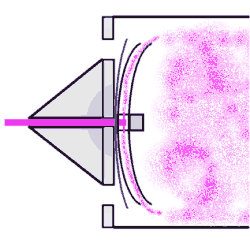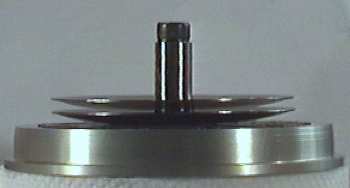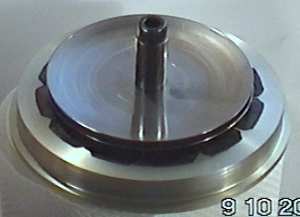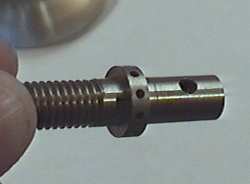Jet engine technologies for interested amateurs
Last Updated: 9 October, 2002
|
A New Valving/Injector Configuration For Small Pulsejets The limited life of traditional pulsejet engines has always been a problem. As detailed here, there are several modes of failure associated withe the reedvalves but the single most critical factor in obtaining longer life out of valves is the temperature at which they operate. In a regular petal-valve engine, the valves often suffer quite significant heating and may even glow red hot in some cases. This obviously affects the temper of the spring steel and significantly weakens them -- thus making the the constant hammering against the valve-head even more damaging. The heat applied to a petal type reed valve generally comes from two sources:
The new system actually produces a power increase while simultaneously providing even better protection against heat damage than the Blast Ring.
Because these disks are also dished in shape, with the curve facing towards the rear of the engine, they also act like a simple valvular conduit and thus significantly reduce the flow of hot gas from the combustion chamber towards the valves. Finally, the fuel is injected into the engine between these two dished disks which means that it provides a cooling effect. This system also allows the direct injection of liquid fuels at relatively low pressure. As it enters the gap between the two disks, the liquid is instantly flashed into vapor which then exits around the periphery of the disks -- thus eliminating the need for a spray nozzle and high pressure (100psi+) fuel pump.
The final benefit of this system is that the fuel vapor is mixed very thoroughly with the incoming airflow as that air passes over the gap between the two disks. This excellent mixing, and the turbulation produced, results in a far more even air/fuel mixture inside the combustion chamber -- and that means more power and better fuel-efficiency.
The 0.65mm stainless steel disks were spun up on my homemade metal spinning lathe and the new fuel jet is also turned from stainless steel with 10 cross-drilled holes to feed the fuel between the two disks. So far, most of the testing has been done with propane but I intend to spend more time conducting tests with methanol and gasoline in the near future.
The stainless steel sleeve you see in the first two pictures
secures the rear disk and is held tight by way of a 6mm cap-head screw.
|
|

 By replacing the valve-retainer with two stainless steel disks that are
separated by a small gap, the amount of heat transfered from the combustion
chamber to the valves is dramatically reduced.
By replacing the valve-retainer with two stainless steel disks that are
separated by a small gap, the amount of heat transfered from the combustion
chamber to the valves is dramatically reduced.
 Gaseous fuels such as propane can still be used perfectly well with this setup and, although
the cooling effect isn't as great as with a liquid fuel, it is still significant.
Gaseous fuels such as propane can still be used perfectly well with this setup and, although
the cooling effect isn't as great as with a liquid fuel, it is still significant.
 As promised, I've finally got some pictures of this setup as I've implemented
it on my PJ15 design.
As promised, I've finally got some pictures of this setup as I've implemented
it on my PJ15 design.
 Here is the gas-fuel jet showing the fuel outlet holes. The large hole to
the right serves no purpose other than to take a torque bar that is used to
tighten the assembly down so that the valves and first disk are held
firmly against the valve-head.
Here is the gas-fuel jet showing the fuel outlet holes. The large hole to
the right serves no purpose other than to take a torque bar that is used to
tighten the assembly down so that the valves and first disk are held
firmly against the valve-head.